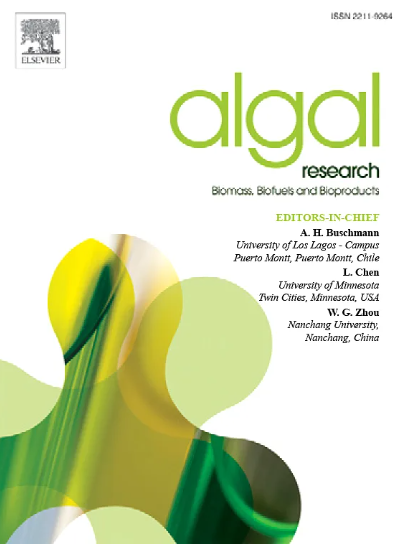藻类和蓝藻介导的金属/金属氧化物纳米颗粒的生物合成及其在食品包装中的潜在应用
IF 4.5
2区 生物学
Q1 BIOTECHNOLOGY & APPLIED MICROBIOLOGY
Algal Research-Biomass Biofuels and Bioproducts
Pub Date : 2025-06-03
DOI:10.1016/j.algal.2025.104124
引用次数: 0
摘要
随着全球对可持续性和生态友好实践的日益重视,纳米颗粒的生物合成已经成为传统化学合成方法的开创性替代方案。在这种情况下,藻类和蓝藻被用作可再生的生物质资源,为纳米颗粒的生产提供了经济上可行、环境友好、易于扩展的平台。藻类和蓝藻提取物包含各种功能大分子和代谢物,不仅可以减少金属盐形成纳米颗粒,还可以形成表面盖层,帮助它们稳定并赋予额外的功能。藻类和蓝藻已经成功地介导了各种纳米颗粒的合成,特别是金属和金属氧化物,显示出特殊的功能和生物学特性。值得注意的是,这些生物合成的纳米颗粒通常可以媲美甚至超过化学合成的纳米颗粒的性能属性,强调了它们在各种工业应用中的潜力。一个特别有前途的应用是在食品包装领域,纳米粒子作为生物聚合物基质的多功能填料,显著提高薄膜特性。然而,传统的化学合成纳米颗粒已经引起了严重的安全和环境问题,加强了对更环保替代品的需求。这一全面的审查独特地解决了这些挑战,明确地关注藻类和蓝藻介导的纳米颗粒合成,并精心讨论了它们在食品包装中的应用前景。这些生物合成的表面功能化纳米颗粒不仅通过增强生物相容性和降低细胞毒性来解决安全问题,而且还可以为食品包装材料提供额外的功能特性,如抗氧化活性,强调其延长食品保质期和确保消费者安全的潜力。本文章由计算机程序翻译,如有差异,请以英文原文为准。
Algae and cyanobacteria-mediated biosynthesis of metal/metal oxide nanoparticles and their potential applications in food packaging
With a growing global emphasis on sustainability and eco-friendly practices, biosynthesis of nanoparticles has emerged as a pioneering alternative to conventional chemical-based synthesis methods. In this context, algae and cyanobacteria have been used as renewable biomass resources, providing an economically viable, environmentally benign, and easily scalable platform for nanoparticle production. Algae and cyanobacteria extracts comprise various functional macromolecules and metabolites that not only reduce the metal salts to form nanoparticles but also form a surface capping, aiding their stabilization and imparting additional functionality. Algae and cyanobacteria have successfully mediated the synthesis of diverse nanoparticles, especially metal and metal oxides, demonstrating exceptional functional and biological properties. Remarkably, these biosynthesized nanoparticles often rival or even surpass the performance attributes of chemically synthesized counterparts, underscoring their potential in various industrial applications. One particularly promising application lies in the food packaging sector, where nanoparticles serve as multifunctional fillers in biopolymer matrices, significantly enhancing film characteristics. Conventional chemically synthesized nanoparticles, however, have raised critical safety and environmental concerns, intensifying the demand for greener alternatives. This comprehensive review uniquely addresses these challenges by focusing explicitly on algae and cyanobacteria-mediated nanoparticle synthesis and meticulously discusses their prospective applications in food packaging. These biosynthesized surface functionalized nanoparticles not only address safety concerns by displaying enhanced biocompatibility and reduced cytotoxicity but also can provide additional functional properties like antioxidant activity to the food packaging materials, emphasizing their potential to extend food shelf-life and ensure consumer safety.
求助全文
通过发布文献求助,成功后即可免费获取论文全文。
去求助
来源期刊

Algal Research-Biomass Biofuels and Bioproducts
BIOTECHNOLOGY & APPLIED MICROBIOLOGY-
CiteScore
9.40
自引率
7.80%
发文量
332
期刊介绍:
Algal Research is an international phycology journal covering all areas of emerging technologies in algae biology, biomass production, cultivation, harvesting, extraction, bioproducts, biorefinery, engineering, and econometrics. Algae is defined to include cyanobacteria, microalgae, and protists and symbionts of interest in biotechnology. The journal publishes original research and reviews for the following scope: algal biology, including but not exclusive to: phylogeny, biodiversity, molecular traits, metabolic regulation, and genetic engineering, algal cultivation, e.g. phototrophic systems, heterotrophic systems, and mixotrophic systems, algal harvesting and extraction systems, biotechnology to convert algal biomass and components into biofuels and bioproducts, e.g., nutraceuticals, pharmaceuticals, animal feed, plastics, etc. algal products and their economic assessment
 求助内容:
求助内容: 应助结果提醒方式:
应助结果提醒方式:


